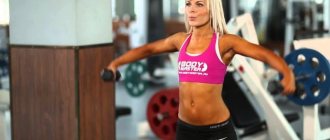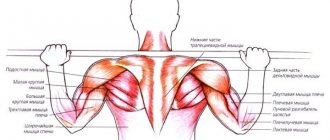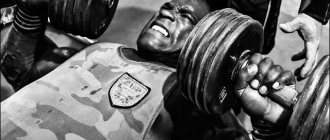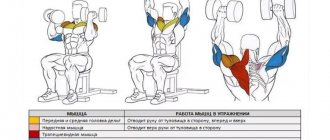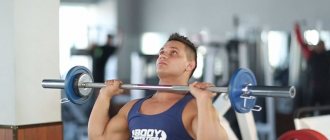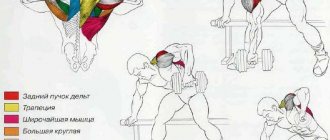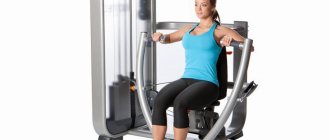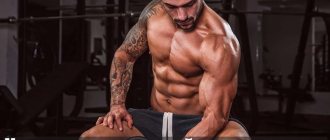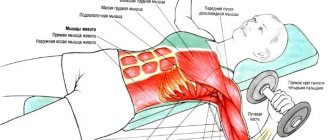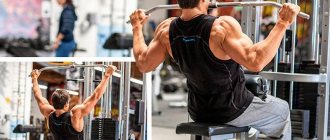This version of the triceps exercise is available to everyone. Unlike the barbell movement, the French press with dumbbells is suitable for complete beginners and those who are not comfortable performing the exercise on a straight bar. The exercise has been used in bodybuilding for a long time, and is inherently not suitable for working at the limit. The exercise is performed in a multi-repetition mode, there are variations while sitting and standing. It is used both in bodybuilding and in strength sports. Can be performed by both men and women. It is isolating in nature and develops the main pressing muscle – the triceps. The choice between the sitting and standing option also depends on the condition of the athlete’s back; for those with a back injury, the exercise option from a sitting position is recommended.
Execution technique
French press with dumbbells standing
Original
- The projectile is taken from the racks with both hands or from the floor by the discs with a locking grip;
- By bending the knee and hip joints, the dumbbell is removed from the floor or racks and thrown back to its original position in one movement;
- The elbows are “in” at the top, the arms are fully straightened;
- The shoulder blades are brought together, the back is slightly arched and tense;
- The abdomen is retracted, the spine is in the anatomically correct position for it, there is no need to bend in the thoracic or lumbar region
Movement:
- Bend your knees slightly to soften your stance;
- Bend your arms at the elbow joints and smoothly lower the dumbbell behind your back;
- Exhale and straighten your arms at the elbow joints, smoothly squeezing the dumbbells upward;
- Do not change the position of your hands on the bar during the exercise.
It's the FRENCH DUMBBELL PRESS, baby.
Seated French press with dumbbells
This exercise can be performed sitting on a dumbbell bench with a backrest, or on a Scott bench, with your back to the biceps racks:
- Take the starting position, dumbbell bar between your thumbs, hands intertwined on the discs;
- Bend your elbows and lower the dumbbell behind your back;
- Extend your arms smoothly, squeezing the dumbbell to the starting position;
- Perform the required number of repetitions as planned
Attention
- The bench press is performed without bending the lower back. It can only be small, determined anatomically; the “bridge” movement should not be performed;
- Elbows should not be spread, forearms should be parallel to each other;
- Shoulders should not rise up or move forward and sideways when performing presses;
- Triceps work better if the position is vertical
Recommendations
- There is no need to “stuff” your neck with a dumbbell. If the discs touch the vertebrae, you should choose a narrower apparatus, or refuse to perform this movement variation and do the exercise in the “one-armed” version;
- The dumbbell cannot be “dropped” down or pushed below the amplitude that is permissible with the natural movement of the arms. Athletes with large biceps should not “clamp” their arms so much that it becomes uncomfortable;
- It is not recommended to work in the upper third of the amplitude, in order to avoid overstretching the elbow ligaments; it is better to perform the movement completely, but use less weight on the projectile than partially, but constantly;
- The bar should fit between your index fingers and thumbs. The grip, when each hand takes the disc separately, is not entirely comfortable and is not anatomically the most advantageous;
- A belayer is necessary not only for heavy lifters, but also for beginners who may not feel very confident.
French press with dumbbells standing and sitting: execution technique
How to pump up triceps with dumbbells: top 5 best exercises
As before, training with free weights remains more effective than training on block machines. The more unstable the position of the body or its individual parts in the exercise, the more muscle fibers are involved.
Dumbbell extension with two hands from behind the head
This exercise works all the triceps muscles of the shoulder (medial, lateral, long) and the ulnar muscle. Performed both standing and sitting:
- Holding with both hands, lift the dumbbell behind your head, keeping your bent elbows as close to your head as possible.
- Exhale: straighten your elbows, straining your triceps; at the top point, leave your elbows slightly bent, this will relieve the load on your elbows. Don't point your elbows out to the sides.
- Inhale: Gently lower the dumbbell behind your head without throwing the weight on your neck.
Perform 4 sets of 8–12 reps.
Standing one-arm dumbbell extension
In this version, a dumbbell triceps extension is performed with only one hand. The work involves the lateral and long head of the triceps, tendon and elbow muscle.
- While standing or sitting, raise your straight arm from the dumbbells above your head, with your hand positioned above your shoulder joint.
- Inhale: Keeping your elbow stationary, lower the dumbbell behind your head without touching your shoulder blade.
- Exhale: straighten your elbow using your triceps. Do not move your shoulder, do not arch your body. If necessary, at the end you can help the triceps with your free hand, pushing out the forearm, or supporting the shoulder in front, for joint stability.
Repeat 8-12 times on one hand, then switch. So 4 approaches.
Read more about how to do a French press sitting and standing here →
Extension of one dumbbell while resting on a bench
For the exercise you will need a horizontal bench. The lateral, long head of the triceps and the ulnar muscle work.
- On one side, we rest the palm of our left hand and the knee of our leg of the same name on the bench. The second (right) leg is with the foot on the floor, and the free hand holds a dumbbell.
- Raise the elbow of the right hand from the dumbbells to the body, constantly maintaining a stationary position from the shoulder to the elbow. The forearm is perpendicular to the floor.
- Exhale: extend the elbow, bringing the arm into a straight line with the body, contracting the triceps as much as possible, holding for a second at the top point.
- Inhale: lower the dumbbell even more slowly to the starting point, relaxing the triceps.
Repeat on one hand 8-12 times, then change to the second. 4 approaches on each side.
Two-arm triceps dumbbell extension
The second name of the exercise is “Grasshopper”. Performed standing in a bent position. In addition to the triceps, the abdominal, back and leg muscles are involved in the work to maintain the position of the body.
- Standing, place your feet hip-width apart. Dumbbells in hands.
- Bend your body with a straight back to a horizontal line, bending your knees. do not round your lower back in any way .
- Raise and press your elbows toward your body, keeping your shoulder motionless. Forearms are freely lowered with dumbbells towards the floor.
- Exhale: Fully extend both arms until they are parallel to the floor. Hold the dumbbells for a second at the top point.
- Inhale: slowly and smoothly lower the dumbbells to the starting point.
Perform 8-12 times, as usual - 4 approaches.
Standing one-arm dumbbell extension
The exercise technique is similar to the previous version of two-arm extensions, but is slightly simplified due to the emphasis on one arm.
- With your feet together, knees bent, bend your back straight forward, resting your forearm on your thigh, stabilizing the position. The second free hand holds a dumbbell.
- As in the previous version, press your elbow to your body, slightly raising your shoulder and turning your body towards the dumbbell. The forearm is free at the bottom.
- Exhale: Fully extend your elbow, pausing.
- Inhale: Slowly lower the dumbbell.
Perform on one side, then change, total - 4x8-12.
Option No. 2
The option assumes the same body position and extension technique, the only difference is the emphasis on the legs.
- With your feet together, take a step back with your right leg, taking a half-split position - your right leg is straight on the toe, the knee of your left leg is at a right angle.
- Place your left elbow on your left thigh.
- The right hand with dumbbells is pressed to the body, and the body is also slightly turned out.
- Exhale: the right arm performs full extension of the dumbbell.
- Inhale: slowly lower the dumbbell down.
- Switch the position in the floor splits to the other side, performing the extension on the left arm 8-12 times. 4 approaches for each hand.
Recommendations: how to pump up your triceps with dumbbells
- To properly work out the triceps with dumbbells, you don’t need heavy weights .
- The slower you perform the relaxation phase (lowering the weight), the more load the triceps will receive, and therefore the better it will pump.
- At the top point, take a short pause , perform extension faster than bending.
Girls can work on the triceps less intensively; to tone this problem area, 3 sets of 15–20 times with light weight are enough. The main thing is the burning sensation on the last repetitions.
Triceps exercises with dumbbells in video format
And also read how to properly stretch after a workout. A selection of triceps exercises for girls at home in this article → Triceps training in the gym is described here → Exercises with dumbbells for biceps.
Variations of the exercise
The movement can be adapted to almost any anatomical feature, be it broad shoulders, large hands, insufficient flexibility of the shoulder joint, and the inability to connect the hands on dumbbell discs.
French press sitting or standing with two dumbbells
This option is indicated for those who experience discomfort when performing movements on the bar and cannot hold the weight behind their head or bend both arms at the same time due to the large volume of muscles. This option is also suitable for those whose triceps are developed differently, and one hand takes on the entire load.
The exercise technically replicates the single dumbbell variations, but you need to hold two dumbbells and perform the movement in sync.
Some people recommend holding the dumbbells together, but this is not suitable if the reason for choosing this option is a shoulder injury. In this case, the forearms are held parallel to each other.
One-arm overhead extension
This option is better suited for those who experience discomfort and are faced with different development of both halves of the body. Those who have one triceps weaker than the other usually perform “one-armed” versions of exercises simply because this allows them to achieve harmonious development. This extension variation is widely used in bodybuilding. You can also perform the exercise by holding one forearm with the opposite hand.
Technically, the movement has its own characteristics - you can bend your arm so that the forearm is perpendicular to the spine, or parallel, but then the shoulder is held with the help of the second hand. Otherwise, the movement resembles the version with one dumbbell - flexion and extension at the elbow joint.
The most important point in all technical variations of the exercise is keeping the elbow and forearm in the same position. If the elbow moves along a trajectory and plane, the athlete performs the exercise incorrectly and takes some of the load off the triceps. Shoulder movement is also not allowed. The elbows should be fixed at one point throughout the exercise. If you can’t hold them, you should consider doing the exercise with a rope handle, either with your forearm secured against the wall, or with your free hand.
The Best Dumbbell Exercises to Develop Your Triceps
The material was prepared by the site team with the support of our experts: athletes, coaches and nutrition specialists. Our team >>
- Reading time: 6 min.
- Dumbbell Bench Press
- Dumbbell press from behind the head
- French bench press
- Bent over arm extension
- Seated dumbbell press
- Triceps technique
The triceps brachii muscle or extensor arm, as has been repeatedly said, forms 2/3 of its volume. But it is important to pump the triceps not on its own, but together with the biceps, so that there is no hypertonicity of one of the antagonists. Triceps exercises with dumbbells will help you build powerful arms. They can be done at home.
Dumbbell Bench Press
You will need a narrow bench. You can put 3 stools in a row and put an elastic thin rug on top of them.
This exercise imitates a close-grip barbell press, but is performed with dumbbells and is suitable for home workouts.
- Lie down on an improvised bench so that your head and pelvis are supported, legs apart so that your position is stable.
- It’s better to take dumbbells this way: when you pick them up from the floor, you’re still standing. Sit on a bench with your knees apart and the dumbbells on your knees. Next, take a horizontal position, while simultaneously raising the dumbbells above your chest and straightening your arms.
- Unfold the dumbbells as if their bars were one continuous line and bring them closer to each other. The outer ends can be raised a little - it will be more convenient.
- Now, while inhaling, lower the dumbbells to your chest near its bottom. And as you exhale, lift the dumbbells up to the starting position. We try to bring the elbows towards the body; they do not need to be spread to the sides as in chest presses.
Perform the exercise 8-10 times in 4 approaches. You can replace it with this variation or alternate approaches:
- Rotate the dumbbells so that your palms are facing each other. That is, the vultures are parallel to each other.
- Press your elbows to your body, lower the dumbbells to the bottom of your chest again as you inhale, and lift them as you exhale.
Note that in this position the load is better removed from the chest and shoulders, and more on the triceps. Afterwards, you can rotate the brushes to their original position for variety.
The main thing is not to twist your wrist and do not lower the dumbbells below your chest. In the latter case, a significant part of their weight will go to the front deltoids.
We work slowly, lifting the weight as we exhale, and lower the dumbbells back as we inhale. No throwing weight on your chest, no pushing.
If you are trying to push the weight to the top or bending, the chosen weight is too heavy for you. Remove excess weights from dumbbells
Dumbbell press from behind the head
Sit on a chair with a rigid vertical back. Rocking chairs are definitely not for you. Take dumbbells and place them on your knees - from this position it will be convenient to throw them up.
It is more convenient to do this exercise with one hand, since you can help install the dumbbell to the starting position with the other. This way you can take more weight on your hand than with the synchronized double version. By the way, the single option can help you in cases where one hand is stronger than the other.
Therefore, consider the option with one dumbbell:
- Raise your arm with the dumbbell bent at the elbow so that your elbow points toward the ceiling. With your other hand, comfortably grasp the working one, helping to fix it in a stable position. You can take your elbow with your palm on top - whatever is more comfortable for you.
- When you bend your arm, the dumbbell will not go back, but to the side behind your head.
- When performing the movement, make sure that your working arm from elbow to shoulder does not change its position.
- Smoothly lower and raise the weight.
Perform 10-12 repetitions of this exercise in 3-4 sets for each arm.
If you cannot straighten your arm on your own during the last repetitions, help with your other hand. But the working arm must be able to withstand controlled bending under the gravity of the dumbbell itself. This is work “for the negative”.
This is allowed only on the last repetitions. If it starts from the very first repetition, the weight is too heavy. It should be reduced, otherwise you risk getting a sprain.
There is a variation of this exercise that affects both hands:
- In this case, you need to grab the dumbbell with both hands so that it passes between your thumb and index finger. Straighten your arms with a dumbbell above your head.
- Slowly lower the weight behind your head and return to the starting position. With this option, the dumbbell goes not to the side, but back. And you should try to bring your elbows towards your ears.
It is important to control your elbows so that they are fixed and do not move during the movement. This is easier to achieve in a lying position, so consider the following exercise.
French bench press
A very effective exercise with dumbbells for triceps. It is often recommended for the development of the triceps muscle, but, unfortunately, it is not suitable for everyone. Some people's elbows start to hurt after it.
If this happens to you, try exercising with bandages, and at the same time take chondroprotectors. Did not help? Choose something else, since your elbows are heavily loaded in this exercise.
In the first exercise you assembled a bench of three stools - we will need it again.
- Take dumbbells, sit down and place them on your knees. Next, carefully lie down on our bench, moving the dumbbells to your chest.
- Now that you are in a stable position, straighten your arms above you and rotate your elbows so that they are facing your feet. This position at the elbows will be with straightened arms. Shoulders perpendicular to the floor.
- When you bend your arms and begin the exercise, your shoulders will need to be slightly tilted towards your head, and your elbows will be pointing towards the top joint between the wall and the ceiling. That is, the arms up to the elbow are no longer perpendicular to the floor, but have a slight tilt towards the head. This position is necessary for the triceps to work throughout the exercise. When the shoulders are perpendicular, at the moment of full bending of the arms, the triceps relaxes. But the French press does not allow this.
- Gently perform arm curls and arm extensions. Make sure that your elbows do not move out to the sides. They need to be kept as close to each other as possible.
Use a grip on the dumbbells as if you were holding a barbell. They can then be deployed.
That is, you can do 4 approaches, 2 of which should be done with this grip, and 2 with a parallel grip. Number of repetitions – 8–10.
Bent over arm extension
Quite technically complex, but useful exercise for triceps with dumbbells.
You can do it standing or lying down. The second option is inconvenient because the back will interfere with straightening your arms. Therefore, you will have to spread your elbows slightly to the sides. It turns out that in this position the arms will be without support and are supported by the back. In addition to the triceps, the back along with the rear deltoids will also be loaded. It is better to avoid this, so it is better to perform the exercise while standing.
- Lean forward, place the same knee and palm on the bench. Turn your body slightly towards your working hand with the dumbbell.
- The elbow of the working arm is pulled straight back, the shoulder is parallel to the floor. The forearm is pointing down. During the exercise, the arm should be fixed from the elbow to the shoulder joint.
- Extend your arm and return the dumbbell to its starting position.
Pay attention to the sensations - if such an exercise causes you discomfort or pain, you are doing something wrong.
Seated dumbbell press
Together with the triceps, you can pump up the shoulders. One of the basic exercises for them is the bench press while sitting behind your head. Why not do the same with dumbbells.
- In order not to load your shoulders more than necessary, you need to spread your elbows to the sides so that they form one straight line with each other. To do this, you need to unfold the dumbbells as if you were holding a barbell in your hands.
- Straighten your arms and lift the dumbbells, bringing them together slightly (no need to hit each other).
- Lower the weight so that your shoulder bones form one straight line. The dumbbells will be approximately at the level of your ears. There is no need to lower them lower - the trapezius muscles are connected.
Do 3-4 sets of 8-10 repetitions. On the one hand, the triceps here do not work to their full amplitude, as in the bench press, but on the other hand, they are well loaded together with the shoulder muscles.
Triceps technique
How to properly pump your triceps:
- We perform all movements smoothly and carefully. Faster movement as you exhale, slower as you inhale.
- We fix the position of the elbows.
- We remember that triceps exercises can also cause harm. Inaccurate movement, working with weights for which you are not yet ready can damage the tendon. Therefore, calculate your strength and follow the technique.
- Wear gloves - this makes it easier to hold the dumbbell in your hands.
If you work without gloves, make sure your hands are not sweaty. In extreme cases, there is talc, chalk, sports magnesium.
Now you know how to pump up your triceps with dumbbells at home. One day, dumbbells will become scarce and your muscles will need a barbell. So it's time for you to hit the gym!
Analysis of the exercise
Anatomy of exercise: which muscles work
- The main movers are the triceps, especially the long and lateral heads. In this exercise, the muscles carry out their main work - they extend the shoulder, working through the elbow joint, there are no anatomically unnatural angles.
- Accessory muscles are all core stabilizers from the abdominals and lats, to the trapezius and core muscles, legs, and elbow muscles. The anterior deltoids, rear deltoids, and pectoralis major muscles stabilize the shoulder position.
Benefits of Exercise
- Promotes full amplitude of muscle stretching, allows for full contraction, since the stretch is full-amplitude;
- The movement helps protect your wrists from injury, since it is easier to hold a dumbbell than a barbell;
- Suitable for those who, for health reasons, cannot work with heavy weights;
- Can be used in women's training;
- Allows you to adjust not only the weight, but also the amplitude, taking into account the developmental characteristics of the athlete, the condition of his shoulders and the amplitude of elbow flexion;
- Suitable for the option with rubber shock absorbers, and weights, as well as sandbags, if dumbbells are not at hand;
- Suitable for those who, due to their large biceps, cannot bench press the barbell in this exercise.
Minuses
- Cannot be used by athletes who, due to the development of the shoulder joint, cannot place their hand behind their ear;
- Should not be used by those who experience pain in the elbows, at least until they see a doctor and get a diagnosis;
- With significant weight, the load falls on the long back muscle, which runs along the spine;
- The exercise cannot be used in training those people who suffer from hernias or protrusions with pain, since using significant weight can lead to even greater displacement of the vertebrae
Exercise for triceps. Arm extensions with a dumbbell.
What muscles are involved in the overhead dumbbell extension?
Extension of arms with dumbbells from behind the head affects our triceps
.
This is the largest muscle in the arm. Or rather its shoulder part. It consists of three heads: medial, middle and long .
But we are only interested in the long(
internal). That is, it is located closer to the body. It is the largest of the three. And this exercise is aimed at its development. And for us this is a very big plus. Since in other exercises the load on this head is much less than on the other two. But it’s the long one that shapes the size of our triceps. Of course, this does not mean that the remaining heads are completely turned off from work. After all, they all have one function, extension of the arm at the elbow joint.
And of course, not a single exercise is complete without stabilizer muscles. This role is played by:
- Forearm. Helps support the weight of the dumbbell.
- Shoulders. Stabilizes the arm when raised.
- Abs and back muscles. The position of our torso is fixed. Eliminates unnecessary stress on the spine.
All these muscles work in static tension.
Preparing for the exercise
This movement is rarely performed at the beginning of a workout or as the only one, so warming up is usually done before starting the exercise. If for some reason the exercise comes first in the plan, you should perform 20-30 flexions-extensions in the elbow joint, and rotations in the shoulder joint.
The exercise should not be performed immediately with a working weight. It is necessary to perform 2-3 warm-up approaches if the weight is heavy, or 1-2 if not significant. “Large” is considered to be a weight close to a third of the athlete’s own body weight.
The movement is not recommended to be included in the plan if the athlete cannot safely move the forearm behind the ear.
Triceps exercises with dumbbells
In this article I will tell you about the most effective triceps exercises, in my opinion, and we will also look at how to perform them. You can perform these exercises both at home and in the gym. You don't need any additional equipment.
French press standing
An excellent exercise for triceps, and accessible to almost everyone.
How to do it?
Take a standing position, legs wider than shoulders, arms straight up. You begin to perform the movement, lower the dumbbell behind your head, up to 90 degrees at the elbow joint. Important! Throughout the entire movement, the elbows should be facing the ceiling, they should not diverge to the sides, and they should not go forward either. When performing, stand straight, do not try to help yourself with your legs, the press should be performed only with the help of the triceps.
How much to do?
Perform 4-5 approaches, 8-12 repetitions. Rest between sets for 1-2 minutes.
Bent-over dumbbell extension
A good exercise for working the triceps, almost everyone can do it, but there are several nuances that I will talk about later.
How to do it?
Take a standing position, leaning forward, arms pressed to the body, legs slightly bent at the knees, forearm directed perpendicular to the floor, at the elbow joint, an angle of approximately 90 degrees. You begin to perform the exercise, straighten your arms, contracting your triceps, and then return your arms to the starting position. Important! When performing the exercise, your back must be straight. Perform extensions in a calm manner, lowering your arms to the starting point rather than throwing them, i.e. the lowering must also be controlled.
How much to do?
You also perform 4-5 sets of 8-12 repetitions, choose the rest according to your condition, but no more than 2 minutes, personally I rest for 1.5 minutes.
Lying dumbbell triceps press
This press is a little different from the usual presses.
How to do it?
Take a lying position on a bench, arms straight up, at shoulder level, neutral grip, i.e. the brushes look at each other. You begin to perform the exercise by lowering the dumbbells, but in this case, the elbows do not go to the sides, but parallel to the body; they should not be directly pressed to the body.
How much to do?
Perform 4 sets of 8-12 repetitions.
If the article was useful or interesting:
Proper execution
- During the exercise, the elbows should not “dangle” along the trajectory or diverge to the sides. If it is uncomfortable to hold them in the desired position, and the trapezius is pulled, you should perform the exercise with two dumbbells, or with each hand in turn, with one dumbbell;
- During the exercise, the apparatus should not slide in the hands so that the athlete drops it on his back. It is better to hold the dumbbell in one position by the discs;
- There is no need to force the dumbbell to the back by contracting the biceps; the natural range of motion is sufficient;
- While gripping, your hands hold the projectile in the lock; you don’t need to hold the dumbbell overlapping your palms, as there is a greater chance that it will fall out of your hands;
- A bench with a backrest is more preferable for those who cannot control the position of their back. Ideally, the back should be high enough so that the athlete can press the back of his head against it;
- The pace of movement should be average, you should not “throw” the dumbbell down and actively “push” it up with your hands, the pressing movement should be smooth
Errors
- The movement should not be done by pushing, it should be slow;
- Elbows do not diverge to the sides;
- The forearms do not tend to be parallel with the floor;
- The trapezius does not rise to the ears “forcibly”;
- The back is not rounded;
- In the rack, the knees do not need to be “inserted”; you should leave them inserted;
- But you should straighten your elbows completely, stay in the lower part of the amplitude and just don’t work there
Efficiency Tips
- Usually there is no point in sitting on a bench without a backrest; you can reduce the axial load if you do not move the dumbbell too far back and lean forward. It is difficult to provide all this with a simple sed;
- The movement will be more effective if performed at full amplitude, and not with “maximum” weight. Remember that this is not a strength test exercise, but a muscle-shaping movement that is suitable for finishing and high-repetition work;
- The option back to the music stand in the Scott bench better supports the shoulder blade area and is suitable for those athletes who tend to hunch over;
- The squat exercise is considered to isolate the triceps better than the rack movement, so it should be performed by those who do not want to lift significant weights.
Top best exercises for triceps with dumbbells
For the sake of mass, it is not enough to train the triceps brachii muscle, or triceps for short, only with multi-joint exercises in the form of presses.
During these basic movements, the pectoral or deltoid muscles take the lion's share of the load, and the triceps do not work at 100%. Therefore, after chest presses or deltoids, as an isolated modification, you need to do triceps exercises with dumbbells.
Unlike a barbell, dumbbells can train each arm separately. This way, the muscles are loaded more intensely due to the possibility of slightly different strength in the left and right hands, which means that with dumbbells the weak hand will not be able to “move out” at the expense of the strong one, as with exercises with a barbell.
Structure and functions of the triceps
Extension of the arm at the elbow joint, for which the triceps brachii muscle is responsible, is the most important function necessary in everyday activities that involve physical activity and movement, as well as in many sports.
Here are some motor tasks of the triceps in sports:
- throwing athletics equipment;
- throwing the ball in basketball;
- hand pushes;
- strikes in martial arts;
- presses of sports equipment.
The triceps is located on the back of the humerus.
It is divided into three heads or bundles:
- lateral, located somewhat to the side and far from the back;
- long, located closer to the back;
- medial, partially lying under the other two bundles.
Features of triceps training
The triceps muscle takes a relatively long time to recover after training. Considering its auxiliary role in all bench presses, which means an enhanced work regime in total, the muscle should be given rest from three days to a week.
The rest period between target workouts depends on the structure of the split. If the triceps are worked in isolation on the same day as the chest and deltoid muscles, then the recovery time should be approximately 3 days for all these muscle groups.
And separate exercises for triceps should be done less frequently, so that the interval between them reaches up to a week, since working on chest and deltoids presses, and then in a separate exercise for them, the triceps extensors will be overtrained.
To avoid overtraining, you should do isolated workouts of varying intensity for them.
You can adjust the intensity:
- varying amounts of exercise;
- different number of approaches;
- different number of repetitions, regulated by the weight of the weights.
This alternation of heavy and light targeted training for the triceps is optimal and most effective.
The classic scheme for training the mass of the triceps brachii muscle is:
- The total number of approaches of all exercises is 3-6;
- The number of repetitions in each approach is 8-15.
Basic rules for training triceps with dumbbells
Exercises for most muscles are divided into 2 types:
- Multi-joint;
- Single-joint.
The triceps brachii muscles work during both types of movements:
- bench presses to train the chest muscles;
- standing or sitting presses for deltoids;
- dips on the uneven bars to work the lower bundles of the pectoral muscles;
- various arm extensions with weights.
In multi-joint presses, the triceps play a supporting role, so the most effective exercises for them are single-joint or isolation exercises.
During their execution, the load should be felt specifically on the triceps; for this, the elbow must be kept motionless, and the angle of inclination of the humerus must ensure tension in the target muscle throughout the entire trajectory of movement.
How to effectively and safely perform triceps exercises with dumbbells?
For both men and women, warming up is mandatory before any physical workout, and triceps exercises are no exception.
To warm up your muscles you can do:
- rotation of the arms in the shoulder joints in both directions;
- rotation of the forearms at the elbows in both directions;
- rotation and bending of the hands in all directions;
- arm extensions with light weights, with 15–20 repetitions;
- light push-ups from a wall or bench, holding your hands in front of you;
- push-ups from a bench when it is behind your back and your feet are on the floor, this movement is reminiscent of push-ups on uneven bars.
After warming up, you need to do a triceps stretch. To do this, raise your bent arm with your elbow up, and with your other hand gently press on the raised elbow, trying to move it behind your back. There shouldn't be any pain. Keep the triceps stretched for about 10 seconds. Do the stretch several times for both arms.
Features of the exercises:
- At first, beginners need to forget about heavy weights, forced repetitions and other things for experienced athletes. At first, the weight of dumbbells is selected for each exercise based on the ability to do 3 sets of 10 repetitions. To prevent injuries, you should pay attention to the secure fixation of the dumbbell locks to prevent the weights from slipping off the bar.
- When lifting the weight, you need to inhale, when lowering, exhale. The time interval between approaches for beginners is approximately one and a half minutes. During the pause, you can do a light triceps stretch.
- After training, you need to do a cool-down. It consists of stretching the muscles being trained and walking slowly. You cannot sit or lie down immediately after the approach, as this is harmful to the heart. The heart rate should gradually slow down after intense exercise, not suddenly. For this you need slow walking, which can be done on a treadmill. Walking can be replaced by leisurely pedaling an exercise bike or light work on any cardio machine.
Triceps exercise program with dumbbells for men and women
French press
All variations of the exercise, where the arm is extended with a fixed elbow joint and the humerus pointing towards the head or in front of you, are called the French press. The option in the lying position opens the list, as it requires the heaviest weight.
- You need to grab one dumbbell with both hands.
- Lie with your back on the bench, placing your feet firmly on the floor or placing them on the bench with your knees bent.
- It is better to hold the dumbbell without completely clasping the bar with your hand, since one hand will clasp the other due to the short bar of the dumbbell, but so that both palms rest equally on the dumbbell plate, and the bar passes between the thumbs and palms.
- This symmetrical grip helps distribute the weight of the weight evenly on both hands.
- The elbows are directed towards the ceiling perpendicular to the body and fixed.
- The dumbbell is placed behind the head.
- The hands holding the weight are located near the forehead or slightly closer to the top of the head.
- Slowly straighten your forearms at the elbow joints. At the same time, the elbows are motionless and cannot be moved to the sides, since the load will be distributed unevenly across all muscle bundles.
- Smoothly return the dumbbell to its original position, bending your elbows.
- Perform 1-3 sets of 8-15 repetitions.
Dumbbell overhead press with two hands
- A variation of the previous exercise, but in a standing position, due to which the direction of the humerus is at a different angle to the body.
- This somewhat changes the nature of the load on the muscles - it mainly falls on the upper sections of the triceps, since it is stretched to the maximum, in contrast to lying exercises.
- The gaze should be directed forward, and not at the feet or up - this is better to maintain balance. Feet shoulder-width apart, parallel to each other.
- In the starting position, the dumbbell hangs behind the back, and the hands are at the level of the back of the head.
- Elbows point upward and do not spread to the sides.
- Having fixed your elbow joints, straighten your arms and hold the weight in the top position for a couple of seconds.
- Return the projectile to its original position.
- Do the required number of repetitions and approaches.
Extension of the arm with a dumbbell from behind the head
- This type of extension works the muscle in isolation, as it is performed with each hand separately.
- Many people can find themselves doing one or two more reps with one weight with one arm than the other arm.
- Therefore, an exercise performed with one hand by a man or a girl maximally loads the muscles, despite the possible difference in arm strength.
- For additional fixation of the elbow of the working arm, it can be held with the other hand.
- The clenched fingers of the hand holding the dumbbell are directed inward.
- In all these extensions, you need to achieve maximum isolation of the triceps, excluding the help of the deltoids and pectoral muscles.
Extension of arms with a dumbbell from behind the head while sitting
- The exercise is similar to a standing arm extension, but the sitting position does not allow you to help lift the weight by springing your legs.
- Such assistance is called cheating and is of no benefit to beginners, reducing the effectiveness of the exercise.
- Movements should be smooth and with fixed elbows.
Bent over arm extension with dumbbell
- Loads mainly the lower part of the triceps, since the humerus here is directed towards the pelvis. The free hand rests on the bench.
- The torso, as well as the humerus of the arm holding the dumbbell, are parallel to the floor. The forearm is pointing down.
- Smoothly straighten your arm, fixing your elbow.
- In the unbent state, hold for a couple of seconds and return to the starting position.
- Perform the required number of times.
Lying dumbbell extension
- A variation of the first version of the French press, but with two dumbbells, which gives maximum isolated load on each triceps.
- The benefit of separate exercises for each hand also lies in the fact that various stabilizer muscles work, holding each hand with weights in the desired position.
- When training on block simulators, this effect is practically absent.
Seated bent over arm extension with dumbbell
- The sitting position eliminates the temptation to cheat with your legs.
- But the tilt of the torso in this interpretation of the exercise does not reach a horizontal position, but is 40–60° from the vertical.
- To balance the position, extension is carried out simultaneously with both hands with a dumbbell in each of them.
- The shoulder bones are horizontal, and the elbows extend beyond the level of the back.
- The movement primarily loads the lower areas of the triceps, since here, as in the previous exercise, the humerus bones are directed towards the pelvis, and not towards the head, so the stretching of the triceps is minimal.
Contraindications
Intense triceps exercises are harmful for people suffering from such ailments as:
- osteoarthritis;
- arthritis;
- osteochondrosis of the joints;
- diseases of tendons, ligaments and joints;
- osteoporosis;
- scoliosis;
- various anomalies in the development of osteochondral tissues;
- recovery period after surgery.
Inclusion in the program
The exercise cannot come first in the plan, unless it is an isolated arm workout. If we are talking about chest training, you should first perform bench presses, chest isolating exercises, and work the teres muscle, and only then move on to triceps presses.
Most athletes prefer to first work in strength mode on a bench press or in a triceps push-up rack, and only then “hone” the muscles with high-repetition work.
The exercise is performed both in medium repetition mode, 12-15 repetitions, and in multi-repetition mode. Weights are recommended from light to medium; it may not be worth trying to achieve failure with heavy weights in this exercise.
Contraindications
Many athletes exclude any variations of the French press in order to protect their elbows. This makes sense if we have a strongman who already experiences increased stress on his elbows, but if we are talking about fitness, a couple of approaches with average weight will not critically affect the ligaments of the elbow joint if the athlete performs everything technically correctly.
A complete contraindication to the exercise is any inflammatory processes in the elbows, wrists and shoulders. First you need to heal them, and only then perform isolated exercises with flexion and extension in the joint.
